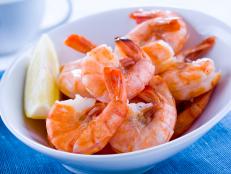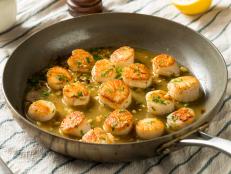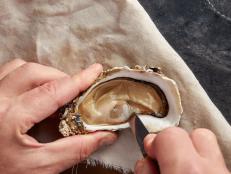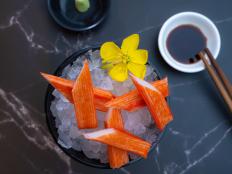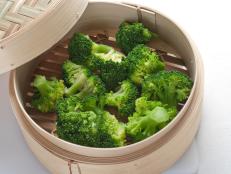How to Steam Shrimp
A step-by-step guide to steaming plump, juicy and flavorful shrimp.

4kodiak/Getty Images
By Carlos C. Olaechea for Food Network Kitchen
Steaming shrimp is one of the best ways to cook the shellfish. The gentle cooking technique helps elevate shrimp’s flavor and tender snap. Below, we walk you through everything you need to know about steaming shrimp, including how to set up your equipment, clean your shrimp, brine it for extra plump and juicy results, flavor your steaming liquid and steam your shrimp to perfection.
Steaming Shrimp vs. Boiling Shrimp
Boiling is another common way to cook shrimp. But here’s why you might want to steam your shrimp. With boiling, there’s a little more room for user error and you can end up with overcooked shrimp. Boiling shrimp can sometimes cook them a little too aggressively and make it difficult to remove your crustaceans from the pot in time. That can translate into shriveled, rubbery shrimp. Moreover, the shrimp’s flavor can leach off into the boiling water. Steaming is much gentler on seafood and helps lock in the shrimp’s flavor. Additionally, steaming is more convenient than boiling because you need less water, which means you don’t have to wait as long for it to come to a boil. The sooner your water comes to a boil, the sooner you can eat!

Eskay Lim / EyeEm/Getty Images
Gather Your Steaming Equipment
The good news is that there are many options you can use to steam shrimp and other shellfish. What you want in your steamer setup is to keep the food elevated from the simmering water below. You want your shrimp to cook in the steam and not boil in the water.
Pot & Steamer Combos
One of the most common setups in the United States consists of a large metal pot with a steamer basket insert which sits on top of the pot. There are holes or perforations at the bottom of the steamer basket to let in steam from the pot below. Sometimes this setup is sold as a pasta pot with a strainer. If you have one of those, you can definitely use it to steam shrimp.
Steamer inserts
If you have a large stock pot or pasta pot but no steamer basket, you can buy a separate steamer basket that fits inside your pot and stands on little feet to keep it elevated from the water. Many also feature a handle to make it easier to lift out of the pot. There are actually many models of steamer inserts available at retailers and online made from different materials like steel and silicone. Some are collapsible, making them easy to store
The Instant Pot
You may be tempted to use the steam function in an Instant Pot or another electronic countertop pressure cooker. However, this isn’t such a great idea. The steam function on an Instant Pot is different from steaming on your stovetop because, in addition to steam, the Instant Pot will also create pressure. You run the risk of overcooking the shrimp, and in the worst scenarios, the pressure may cause your shrimp to break apart. Now, you shouldn’t dismiss your Instant Pot altogether. You can steam shrimp with it using the steamer rack. However, use the sauté setting to make the water come to a simmer. Cover with a cloth or plate instead of the Instant Pot lid to avoid creating a vacuum.
Other Options
You can also use a tamale pot if you have one; they’re very practical if you intend on steaming a lot of shrimp for a large party or gathering. As well, you can use a Chinese-style bamboo steamer over a wok or other pot or pan. Steamer racks that are popular in Chinese and other East Asian cuisines can be quite inexpensive. These are great because they are sturdy enough to support a plate or bowl, which is important if you want to hold onto the shrimp’s juices or if you want to coat or smother your shrimp in a sauce or other aromatics, like scallions and ginger.
No Steamer? No Problem!
If you don’t have special steaming equipment, you can rig a regular stock pot to become a steamer. Simply turn a heat-safe bowl upside down in your pot. Place a heavy, heat-safe plate on top of the overturned bowl and you have yourself an impromptu steamer. A heatproof colander set on top of a pot of simmering water also works perfectly. Alternatively, you can create a steamer from potatoes and corn on the cob by simply layering them inside your pot first along with water or whatever liquid you wish to cook with. Place your shrimp on top of the vegetables, which will keep them elevated above the liquid, and fire up your stove. This is a great way to steam shrimp and also add a side dish to your meal all in one pot.
Steaming Baskets We Love

James Baigrie/Getty Images
Clean the Shrimp
The prep work involved before you steam your shrimp has everything to do with your personal preferences and whether or not you bought your shrimp peeled and deveined. If you love peel-and-eat shrimp, you’ll have less work to do before cooking. If you (or your dinner guests) don’t like working for their food, you’ll have to do a little more work – here’s how.
-
How to remove shrimp heads: If you’ve found whole, head on shrimp, you can steam them whole and be left with super flavorful, juicy shrimp. But that may not be everyone’s idea of good eats. To remove the heads, twist them off or chop them off with a chef’s knife.
-
How to peel shrimp: Peel off the shell segment by segment by grabbing onto the section of shell that meets the belly (where the legs are) and pulling back. If you’re eating shrimp with your hands – like in shrimp cocktail – you can leave the tail so diners can grab a shrimp with their fingers. Otherwise, snip it off with scissors or a knife.
-
How to devein shrimp: The intestinal tract is completely safe to eat but can add sandy texture to your finished product, so many people opt to remove it. To do so, simply use a paring knife to cut a slit along the back of each shelled shrimp, exposing the dark intestinal tract. With the tip of your knife (or with your fingers) remove the tract and discard. Rinse your shrimp, and they are ready to steam.
Brine the Shrimp for Extra Juiciness
Have you ever eaten shrimp at a restaurant that were almost impossibly plump and juicy? The staff probably used the same type of shrimp you get at your local grocery store. However, between cleaning and cooking, they probably brined it. This is a not-so-new technique that many restaurants have used for decades to ensure every diner gets perfect shrimp.
Soak your prepped shrimp for 1 hour before cooking in an ice water-salt brine. 1 tablespoon of salt for every 2 cups of ice water is a good starting point. You can also add 1 tablespoon of sugar and 1 teaspoon of baking soda to the brine like Chinese chefs sometimes do to ensure their shrimp cooks up crisp and snappy instead of soft and mushy. Just make sure to rinse the shrimp before steaming it to wash off the baking soda.

Achiam Photography/Getty Images
Add Flavor to the Shrimp Steaming Liquid
When it comes to seafood, there are people who believe in tasting the pure, natural flavors of shrimp and those who believe shrimp are a vehicle for lots of seasonings. Neither approach is wrong, and steaming lets you add as much or as little flavor to your shrimp as you want. If you are adding extra flavor, what’s important to keep in mind is that your steaming liquid needs to more heavily seasoned than soup or stew broth. Your liquid needs to be almost too flavorful to eat on its own. If your concoction makes you pucker or grab a glass of water, then its steam will impart just enough flavor to your shrimp.
- How to let the shrimp’s simple flavors shine. Use plain water as your steaming liquid. Adding a few slices of lemon is also traditional and lets you focus on the sweet, unadulterated flavors of the shrimp.
- Swap water for another liquid. You can use stock, wine, beer, fruit juices or any other beverages you like. There are no limits to how you can experiment with steaming shrimp.
- Add aromatics to the steaming liquid. Think of vegetables that add a lot of aroma, like onions, celery and carrots. Garlic and ginger are also great additions that impart a lot of flavor. Don’t be afraid to rummage through your spice cabinet and herb garden for inspiration. Chili peppers, black pepper, bay leaves, thyme cilantro and parsley are just some of the many seasonings you can add to your steaming liquid.
Season the Shrimp
Now is a good time to add any extra seasonings directly to your shrimp if you want to jazz them up a bit. Tossing your raw shrimp in some cayenne pepper or black pepper is always a good option for those who like a bit of a kick to their seafood. You may also coat them in a little citrus zest, curry powder or herbs. You can add liquid seasonings to shrimp, too. A splash of vermouth or sherry add a nice note that compliments shrimp’s natural sweetness. A drizzle of oyster sauce or Thai curry paste is another option for a more Asian-influenced preparation. If you are adding liquid seasonings to your shrimp, you will want to steam them on a plate or a bowl so that your seasoning doesn’t fall through the holes of your steamer. By using a plate or bowl, you’ll also end up with a super flavorful sauce for you shrimp.
How to Steam Shrimp
- Add your steaming liquid to the pot. And any other seasonings and aromatics you want.
- Place your steamer insert in the pot. Make sure there are at least two inches between the bottom of your steamer and the top of the liquid. If there is too much water, just remove the steamer and pour out some of the liquid until you have it at the right level.
- Cover the pot and bring the liquid to a boil over high heat. Having your steamer inside your pot at this stage will preheat it and help your shrimp cook just a bit faster.
- Reduce heat to medium and add shrimp. You want the liquid to be at a moderate simmer. Uncover the pot, add your prepared shrimp, and replace the cover.
- Steam until the shrimp they curl and turn bright pink. Steam for 4 to 6 minutes for 1 to 2 pounds of shrimp. Immediately remove the steamer from the pot. The shrimp should have changed color and be firm to the touch but still give a little. Make your hand into a loose fist and poke the area between your thumb and forefinger. Your shrimp should feel like that.
- For cold shrimp, drop into a large bowl filled with ice water. Once they are cooled, you can store them in the refrigerator until you are ready to serve them. They can keep this way for about a day.
Related Links:




























